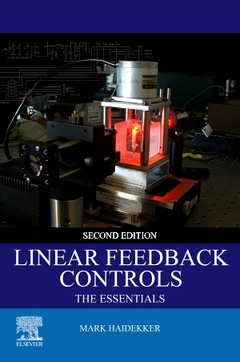Description
Linear Feedback Controls (2nd Ed.)
The Essentials
Author: Haidekker Mark A.
Language: English
Subject for Linear Feedback Controls:
398 p. · 15x22.8 cm · Paperback
Description
/li>Contents
/li>Readership
/li>Biography
/li>Comment
/li>
Control systems are one of the most important engineering fields, and recent advances in microelectonics and microelectromechanical systems have made feedback controls ubiquitous ? a simple cell phone, for example, can have dozens of feedback control systems. Recent research focuses on advanced controls, such as nonlinear systems, adaptive controls, or controls based on computer learning and artificial intelligence. Conversely, classical (linear) control theory is well established; yet, it provides the crucial foundation not only for advanced control topics, but also for the many everyday control systems ranging from cell phone backlight control to self-balancing hoverboard scooters. Linear Feedback Controls provides a comprehensive, yet compact introduction to classical control theory. The present Second Edition has been expanded to include important topics, such as state-space models and control robustness. Moreover, aspects of the practical realization have been significantly expanded with complete design examples and with typical building blocks for control systems.
The book is ideal for upper level students in electrical and mechanical engineering, for whom a course in Feedback Controls is usually required. Moreover, students in bioengineering, chemical engineering, and agricultural and environmental engineering can benefit from the introductory character and the practical examples, and the book provides an introduction or helpful refresher for graduate students and professionals.
Preface to the second edition ix
Preface to the first edition xi
Acknowledgments xiii
List of commonly used symbols xv
1 Introduction to linear feedback controls 1
2 Systems and signals 15
3 Solving differential equations in the Laplace domain 25
4 Time-discrete systems 51
5 First comprehensive example: the temperature-controlled waterbath 65
6 A tale of two poles: the positioner example and the significance of the poles in the s-plane 87
7 State-space models 109
8 Block diagrams: formal graphical description of linear systems 123
9 Linearization of nonlinear components 133
10 Stability analysis for linear systems 145
11 The root locus method 157
12 Frequency-domain analysis and design methods 177
13 Robustness of feedback control systems 203
14 Building blocks of linear systems 219
15 The PID controller 253
16 Design of feedback controls 275
17 Application and design examples 297
A Laplace correspondence tables 363
B Z-transform correspondence tables 367
C Relevant Scilab commands 369
References and further reading 371
Index 373
- Focuses on the essentials of control fundamentals, system analysis, mathematical description and modeling, and control design to guide the reader
- Illustrates how control theory is linked to design of control systems and their performance by introducing theoretical elements as tools in a designer’s toolbox
- Guides the reader through the different analysis and design tools with strands of examples that weave throughout the book
- Highlights both the design process and typical applications by presenting detailed practical examples and their realization and performance, complete with circuit diagrams and measured performance data




